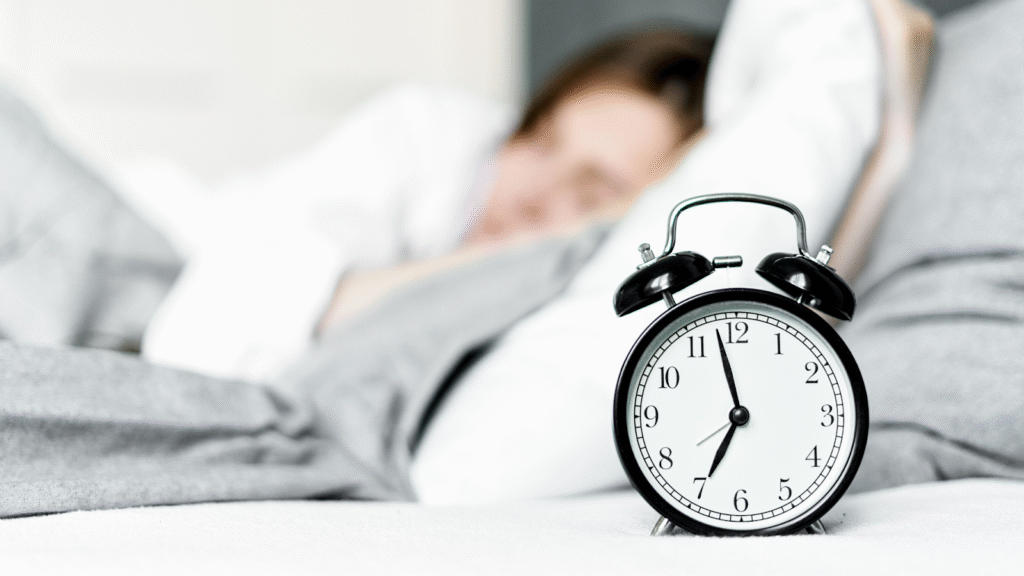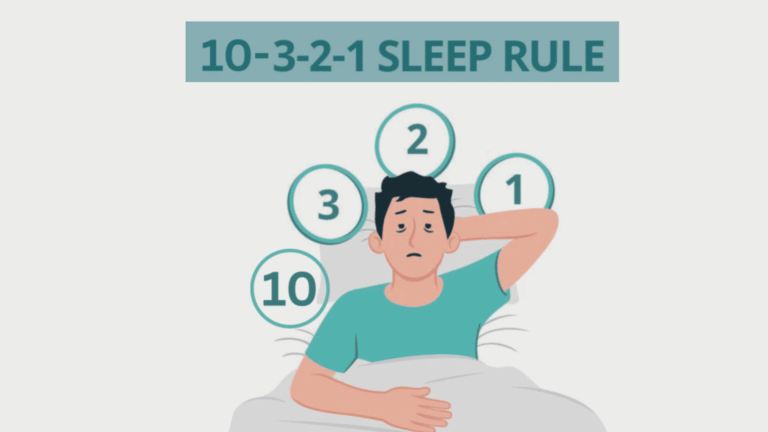Good sleep is not just about quantity — it’s about quality. In today’s world, where screens dominate and stress levels are high, falling asleep easily and waking up refreshed can feel impossible. Enter the 10-3-2-1-0 sleep method — a simple yet effective formula that helps you build healthy sleep habits, improve your bedtime routine, and finally get that deep, restorative rest your body craves.
In this post, we’ll explore what the 10-3-2-1-0 sleep method is, why it works, and how you can apply it to achieve better sleep hygiene and productivity. Whether you’re a night owl or just struggling with irregular sleep patterns, this method can help transform your nightly routine and overall well-being.
What Is the 10-3-2-1-0 Sleep Method?
The 10-3-2-1-0 sleep method was popularized by Dr. Jess Andrade, a physician known for sharing practical wellness tips. This easy-to-follow rule provides a structured timeline before bed to help you prepare both mentally and physically for quality sleep.
Here’s how it works:
- 10 hours before bed: No more caffeine
- 3 hours before bed: Stop eating heavy meals and drinking alcohol
- 2 hours before bed: Stop working or doing stressful mental tasks
- 1 hour before bed: Turn off all screens (TV, phone, computer)
- 0: The number of times you hit snooze in the morning
This sequence sets the stage for better sleep by helping your body wind down naturally and wake up refreshed.

The Science Behind the 10-3-2-1-0 Sleep Method
The 10-3-2-1-0 rule works because it aligns with your body’s circadian rhythm — the internal clock that regulates sleep, hormones, and alertness throughout the day.
Each step targets a specific factor that disrupts sleep quality, helping you remove the obstacles that prevent deep rest.
1. 10 Hours Before Bed: Limit Caffeine
Caffeine has a half-life of around 5–6 hours, meaning it can stay in your system long after your last cup. If you consume caffeine too late, it can reduce slow-wave sleep (deep sleep) and make you feel restless.
By cutting off caffeine 10 hours before bedtime, you give your body enough time to process it fully, helping you fall asleep faster and stay asleep longer.
2. 3 Hours Before Bed: Avoid Heavy Meals and Alcohol
Eating large meals or drinking alcohol close to bedtime can interfere with your body’s ability to relax. Heavy foods may cause indigestion, while alcohol disrupts REM sleep, leading to grogginess the next day.
Stopping food and alcohol intake three hours before sleep gives your digestive system time to settle, promoting a calm, balanced internal state before bed.
3. 2 Hours Before Bed: Stop Working
Work-related stress keeps your mind in “alert mode.” Checking emails or finishing a project activates your sympathetic nervous system, which raises cortisol (the stress hormone).
Shutting down work two hours before bed allows your brain to shift from productivity to relaxation, signaling that it’s time to rest.
4. 1 Hour Before Bed: Turn Off Screens
Screens emit blue light, which suppresses melatonin production — the hormone responsible for sleep. Scrolling through your phone or watching TV tricks your brain into thinking it’s still daytime.
Turning off screens an hour before bed allows melatonin levels to rise naturally, helping you feel drowsy and ready to sleep.
5. 0 Snoozes in the Morning
The “0” is a reminder not to hit the snooze button. Each time you do, you enter a new sleep cycle but wake up before it completes, leaving you more tired.
Getting up immediately when your alarm rings helps regulate your body clock and boosts morning energy and alertness.
Why the 10-3-2-1-0 Sleep Method Actually Works
This method is effective because it addresses multiple dimensions of sleep hygiene — mental, physical, and environmental factors.
Here’s why it makes a real difference:
- It establishes a consistent routine. Repetition signals to your body that it’s time to wind down, improving circadian rhythm stability.
- It reduces sleep inhibitors. By cutting caffeine, food, and screens, you eliminate common triggers that keep you awake.
- It lowers stress and anxiety. Setting boundaries around work and screens calms the mind and prepares it for rest.
- It boosts overall health. Better sleep enhances focus, metabolism, immunity, and emotional balance.
Think of this method as a step-by-step sleep preparation system — one that transitions your body from alert to relaxed in a predictable, healthy way.
How to Implement the 10-3-2-1-0 Sleep Method in Your Routine
Adopting this method doesn’t mean perfection from day one — it’s about building consistency. Here’s how to ease into it:
Step 1: Identify Your Target Bedtime
Start by setting a realistic bedtime and wake-up time. Aim for 7–9 hours of sleep depending on your lifestyle and energy needs.
Step 2: Work Backward
Use the 10-3-2-1-0 rule to calculate your schedule:
- Bedtime: 10:00 p.m.
- Caffeine cut-off: 12:00 p.m.
- Stop eating/drinking: 7:00 p.m.
- Stop working: 8:00 p.m.
- No screens: 9:00 p.m.
Step 3: Create a Nighttime Routine
Use the last hour before bed for relaxation activities:
- Read a physical book
- Stretch or do light yoga
- Meditate or practice deep breathing
- Journal your thoughts
- Listen to calm, instrumental music
Step 4: Keep Devices Out of the Bedroom
Charge your phone outside the bedroom to reduce temptation. If you use your phone as an alarm, switch to a traditional clock instead.
Step 5: Stick With It
Consistency is key. Try the 10-3-2-1-0 sleep method for at least two weeks to notice measurable improvements in energy, focus, and mood.
Benefits of the 10-3-2-1-0 Sleep Method
Following this sleep strategy can lead to significant improvements in both your physical health and mental clarity.
Here are the top benefits:
1. Improved Sleep Quality
By removing late-night stimulants and distractions, you’ll fall asleep faster and experience deeper, more restorative rest.
2. Increased Morning Energy
Waking up without snoozing trains your internal clock, reducing morning grogginess and helping you start your day energized.
3. Reduced Stress and Anxiety
The two-hour work cut-off and one-hour screen break create a calming pre-sleep environment that eases mental tension.
4. Better Focus and Productivity
Quality sleep enhances cognitive performance, memory, and decision-making — making you sharper throughout the day.
5. Enhanced Physical Health
Consistent rest supports immune function, metabolism, and hormonal balance, contributing to long-term wellness.
Common Mistakes to Avoid When Following the 10-3-2-1-0 Rule
Even with the best intentions, small missteps can weaken the effectiveness of this method. Avoid these common pitfalls:
- Consuming hidden caffeine: Remember that tea, chocolate, and energy drinks contain caffeine too.
- Eating “light snacks” late at night: Even small, spicy, or sugary snacks can trigger indigestion.
- Scrolling right before bed: Blue light and social media overstimulation are sleep disruptors.
- Working past your cutoff time: Emails and late-night brainstorming sessions can delay melatonin release.
- Inconsistent wake-up times: Irregular sleep patterns can confuse your circadian rhythm.

Bonus Tips for Better Sleep Hygiene
To maximize the benefits of the 10-3-2-1-0 method, pair it with these simple sleep hygiene practices:
- Keep your bedroom cool (around 18–20°C or 65–68°F).
- Use blackout curtains or an eye mask to block light.
- Limit naps to 20–30 minutes earlier in the day.
- Avoid nicotine, which can disrupt deep sleep.
- Try relaxation apps or guided meditations for mindfulness.
- Stick to a consistent sleep schedule, even on weekends.
These small adjustments, combined with the 10-3-2-1-0 framework, can completely transform your relationship with sleep.
What Happens If You Skip the 10-3-2-1-0 Routine?
Ignoring this routine occasionally won’t ruin your sleep forever — but over time, poor sleep hygiene can lead to:
- Chronic fatigue
- Difficulty concentrating
- Irritability or mood swings
- Weakened immune system
- Weight fluctuations
Your body thrives on rhythm and consistency. That’s why following the 10-3-2-1-0 rule regularly helps maintain steady energy levels and mental balance day after day.
Real-Life Example: A Night Owl’s Transformation
Consider Sarah, a 29-year-old digital marketer who used to stay up until 1 a.m. working or watching shows. She struggled with fatigue, headaches, and poor focus.
After applying the 10-3-2-1-0 sleep method for just three weeks:
- She stopped afternoon coffee runs.
- She replaced evening Netflix binges with journaling.
- She set a strict work cut-off and avoided screens before bed.
Result? She started falling asleep by 10:30 p.m., waking up refreshed at 6:30 a.m., and noticed a dramatic boost in her mood and productivity.
The Takeaway: Simplicity That Delivers Results
The 10-3-2-1-0 sleep method isn’t complicated — it’s practical and backed by science. It helps you rewire your pre-sleep habits, improve focus, and restore natural sleep cycles.
By following these five simple steps — no caffeine, no late meals, no work, no screens, and no snoozing — you can transform your nightly routine into a calming ritual that promotes health, energy, and mental clarity.
Starting tonight. Set your bedtime, follow the timeline, and wake up tomorrow feeling like your best self.
Ready to Improve Your Sleep?
If you found this guide helpful, subscribe to our newsletter for more wellness tips, sleep hacks, and healthy lifestyle routines that fit your everyday life. Better sleep starts with small steps — and the 10-3-2-1-0 method is the perfect first one.


